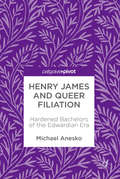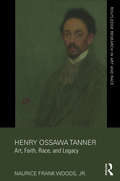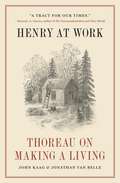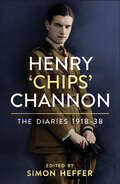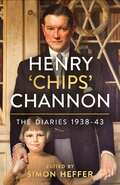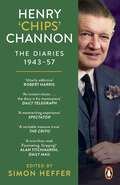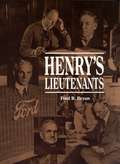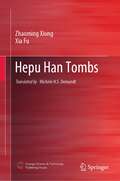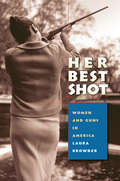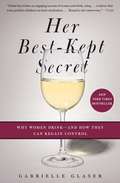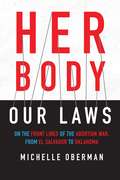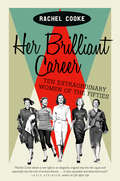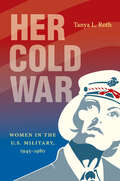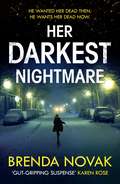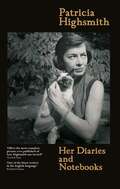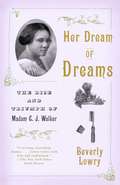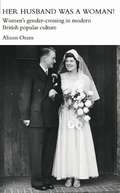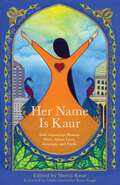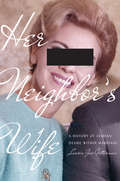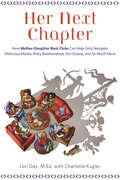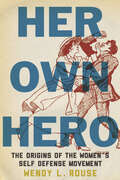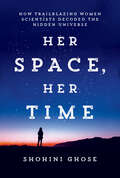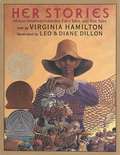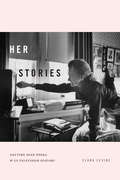- Table View
- List View
Henry James and Queer Filiation: Hardened Bachelors Of The Edwardian Era
by Michael AneskoThis study challenges the notion that closeted secrecy was a necessary part of social life for gay men living in the shadow of the trial and imprisonment of Oscar Wilde. It reconstructs a surprisingly open network of queer filiation in which Henry James occupied a central place. The lives of its satellite figures — most now forgotten or unknown — offer even more suggestive evidence of some of the countervailing forms of social practice that could survive even in that hostile era. If these men enjoyed such exemption largely because of the prerogatives of class privilege, their relative freedom was nevertheless a visible rebuke to the reductive stereotypes of homosexuality that circulated and were reinforced in the culture of the period. This book will be of particular interest to scholars of Henry James and queer studies, readers of late Victorian and modern literature, and those interested in the history and social construction of gender roles.
Henry Ossawa Tanner: Art, Faith, Race, and Legacy (Routledge Research in Art and Race)
by Naurice Frank Woods, Jr.Over the last forty years, renewed interest in the career of Henry Ossawa Tanner (1859–1937) has vaulted him into expanding scholarly discourse on American art. Consequently, he has emerged as the most studied and recognized representative of African American art during the nineteenth century. In fact, Tanner, in the spirit of political correctness and racial inclusiveness, has gained a prominent place in recent textbooks on mainstream American art and his painting, The Banjo Lesson (1893), has become an iconic symbol of black creativity. In addition, Tanner achieved national recognition when the Philadelphia Museum of Art in 1991 and the Pennsylvania Academy of the Fine Arts in 2012 celebrated him with major retrospectives. The latter exhibition brought in a record number of viewers. While Tanner lived a relatively simple life where his faith and family dictated many of the choices he made daily, his emergence as a prominent black artist in the late nineteenth century often thrust him openly into coping with the social complexities inherent with America’s great racial divide. In order to fully appreciate how he negotiated prevailing prejudices to find success, this book places him in the context of a uniquely talented black man experiencing the demands and rewards of nineteenth-century high art and culture. By careful examination on multiple levels previously not detailed, this book adds greatly to existing Tanner scholarship and provides readers with a more complete, richly deserved portrait of this preeminent American master.
Henry at Work: Thoreau on Making a Living
by John Kaag Jonathan van BelleWhat Thoreau can teach us about working—why we do it, what it does to us, and how we can make it more meaningfulHenry at Work invites readers to rethink how we work today by exploring an aspect of Henry David Thoreau that has often been overlooked: Thoreau the worker. John Kaag and Jonathan van Belle overturn the popular misconception of Thoreau as a navel-gazing recluse who was scornful of work and other mundanities. In fact, Thoreau worked hard—surveying land, running his family’s pencil-making business, writing, lecturing, and building his cabin at Walden Pond—and thought intensely about work in its many dimensions. And his ideas about work have much to teach us in an age of remote work and automation, when many people are reconsidering what kind of working lives they want to have.Through Thoreau, readers will discover a philosophy of work in the office, factory, lumber mill, and grocery store, and reflect on the rhythms of the workday, the joys and risks of resigning oneself to work, the dubious promises of labor-saving technology, and that most vital and eternal of philosophical questions, “How much do I get paid?” In ten chapters, including “Manual Work,” “Machine Work,” and “Meaningless Work,” this personal, urgent, practical, and compassionate book introduces readers to their new favorite coworker: Henry David Thoreau.
Henry ‘Chips’ Channon (Volume 1): 1918-38
by Chips ChannonThe Sunday Times bestselling edition of Chips Channon's remarkable diaries.Born in Chicago in 1897, 'Chips' Channon settled in England after the Great War, married into the immensely wealthy Guinness family, and served as Conservative MP for Southend-on-Sea from 1935 until his death in 1958. His career was unremarkable. His diaries are quite the opposite. Elegant, gossipy and bitchy by turns, they are the unfettered observations of a man who went everywhere and who knew everybody. Whether describing the antics of London society in the interwar years, or the growing scandal surrounding his close friends Edward VIII and Wallis Simpson during the abdication crisis, or the mood in the House of Commons in the lead up to the Munich crisis, his sense of drama and his eye for the telling detail are unmatched. These are diaries that bring a whole epoch vividly to life. A heavily abridged and censored edition of the diaries was published in 1967. Only now, sixty years after Chips's death, can an extensive text be shared.________________________________'Chips perfectly embodied the qualities vital to the task: a capacious ear for gossip, a neat turn of phrase, a waspish desire to tell all, and easy access to the highest social circles across Europe.[...] Blending Woosterish antics with a Lady Bracknellesque capacity for acid comment. Replete with fascinating insights.' Jesse Norman, Financial Times
Henry ‘Chips’ Channon (Volume 2): 1938-43
by Chips ChannonThe second volume of the remarkable, Sunday Times bestselling diaries of Chips Channon.'A masterpiece - a time machine that transports the reader back to British politics and high society at the end of the 1930s.' Robert Harris'The uncensored, unvarnished thought of one of the 20th century's greatest diarists. - Best Biographies of the Year, Telegraph'An unrivalled guide to the social and political life of Britain in the first half of the 20th century.' Books of the Year, The Times'Fascinating.' New Statesman'Never a dull day, never a dull sentence.' Daily Mail_______________________________________________This second volume of the bestselling diaries of Henry 'Chips' Channon takes us from the heady aftermath of the Munich agreement, when the Prime Minister so admired by Chips was credited with having averted a general European conflagration, through the rapid unravelling of appeasement, and on to the tribulations of the early years of the Second World War. It closes with a moment of hope, as Channon, in recording the fall of Mussolini in July 1943, reflects: 'The war must be more than half over.'For much of this period, Channon is genuinely an eye-witness to unfolding events. He reassures Neville Chamberlain as he fights for his political life in May 1940. He chats to Winston Churchill while the two men inspect the bombed-out chamber of the House of Commons a few months later. From his desk at the Foreign Office he charts the progress of the war. But with the departure of his boss 'Rab' Butler to the Ministry of Education, and Channon's subsequent exclusion from the corridors of power, his life changes - and with it the preoccupations and tone of the diaries. The conduct of the war remains a constant theme, but more personal preoccupations come increasingly to the fore. As he throws himself back into the pleasures of society, he records his encounters with the likes of Noël Coward, Prince Philip, General de Gaulle and Oscar Wilde's erstwhile lover Lord Alfred Douglas. He describes dinners with members of European royal dynasties, and recounts gossip and scandal about the great, the good and the less good. And he charts the implosion of his marriage and his burgeoning, passionate friendship with a young officer on Wavell's staff.These are diaries that bring a whole epoch vividly to life.
Henry ‘Chips’ Channon: The Diaries (Volume 3): 1943-57
by Chips ChannonThe third and final volume of the remarkable Sunday Times bestselling diaries of Sir Henry 'Chips' Channon___________________________________________'An utterly addictive glimpse of London high society and politics in the 40s and 50s.' Robert Harris'An instant classic . . . quite simply the greatest social and political diaries of the 20th century.' Daily Telegraph'Rich, exuberant, copious and shatteringly honest.' Spectator'A scurrilous read. Fascinating. Gripping!' Alan Titchmarsh'Chips writes with such vividness that one feels one is living each day in his exalted company.' The Oldie_______________________________________This final volume of the unexpurgated diaries of Sir Henry 'Chips' Channon begins as the Second World War is turning in the Allies' favour. It ends with Chips descending into poor health but still able to turn a pointed phrase about the political events that swirl around him and the great and the good with whom he mingles.Throughout these final fourteen years Chips assiduously describes events in and around Westminster, gossiping about individual MPs' ambitions and indiscretions, but also rising powerfully to the occasion to capture the mood of the House on VE Day or the ceremony of George VI's funeral. His energies, though, are increasingly absorbed by a private life that at times reaches Byzantine levels of complexity. We encounter the London of the theatre and the cinema, peopled by such figures as John Gielgud, Laurence Olivier, Vivien Leigh and Douglas Fairbanks Jr, as well as a seemingly endless grand parties at which Chips might well rub shoulders with Cecil Beaton, the Mountbattens, or any number of dethroned European monarchs.He has been described as 'The greatest British diarist of the 20th century'. This final volume fully justifies that accolade.
Henry's Lieutenants
by Ford R. BryanAlthough Henry Ford gloried in the limelight of highly publicized achievement, he privately admitted, "I don't do so much, I just go around lighting fires under other people." Henry's Lieutenants features biographies of thirty-five "other people" who served Henry Ford in a variety of capacities, and nearly all of whom contributed to his fame. These biographical sketches and career highlights reflect the people of high caliber employed by Henry Ford to accomplish his goals: Harry Bennett, Albert Kahn, Ernest Kanzler, William S. Knudsen, and Charles E. Sorenson, among others. Most were employed by the Ford Motor Company, although a few of them were Ford's personal employees satisfying concurrent needs of a more private nature, including his farming, educational, and sociological ventures. Ford Bryan obtained a considerable amount of the material in this book from the oral reminiscences of the subjects themselves.
Hepu Han Tombs
by Zhaoming Xiong Xia FuThis is the first book to systematically study the Hepu Han Tombs. Covering an area of about 68 square kilometers, the Hepu Han Tombs is one of the largest-scale and best-preserved ancient tombs in China. In 2001, the remains of 1,056 grave mounds could be seen on the earth surface and it was estimated that almost 10,000 tombs still survived underground. In the last 60 years, over 1,200 tombs have been excavated at Hepu, with approximately 20,000 artefacts unearthed which include pottery, bronze, iron, gold and silver ware, jade, lacquer, glass and bead ornaments. Especially to deserve to be mentioned, a large amount of artefacts can be related to the Maritime Silk Road. From the 2nd century B.C. to the 3rd century A.D., the Hepu Port served as the eastern starting point of the Maritime Silk Road, opening up trade and cultural exchange with countries in Southeast Asia, South Asia, West Asia, and the Mediterranean world, which resulted in a vast maritime trade network between China and the West. And these artefacts provide important evidence about this route, which also confirm the records of Chinese official history books. Therefore, the Hepu Han Tombs is of great significance to the study of ancient Chinese history and cultural exchanges between China and the West.
Her Best Shot
by Laura BrowderThe gun-toting woman holds enormous symbolic significance in American culture. For over two centuries, women who pick up guns have disrupted the popular association of guns and masculinity, spurring debates about women's capabilities for violence as well as their capacity for full citizenship. In Her Best Shot, Laura Browder examines the relationship between women and guns and the ways in which the figure of the armed woman has served as a lightning rod for cultural issues.Utilizing autobiographies, advertising, journalism, novels, and political tracts, among other sources, Browder traces appearances of the armed woman across a chronological spectrum from the American Revolution to the present and an ideological spectrum ranging from the Black Panthers to right-wing militias. Among the colorful characters presented here are Deborah Sampson, who disguised herself as a man to fight in the American Revolution; Pauline Cushman, who posed as a Confederate to spy for Union forces during the Civil War; Wild West sure-shot Annie Oakley; African explorer Osa Johnson; 1930s gangsters Ma Barker and Bonnie Parker; and Patty Hearst, the hostage-turned-revolutionary-turned-victim. With her entertaining and provocative analysis, Browder demonstrates that armed women both challenge and reinforce the easy equation that links guns, manhood, and American identity.The gun-toting woman holds enormous symbolic significance in American culture. Laura Browder examines the relationship between women and guns in America and the ways in which the figure of the armed woman has served as a lightning rod for cultural issues. In an entertaining and provocative analysis, she looks at women including Deborah Sampson, who disguised herself as a man to fight in the American Revolution; Pauline Cushman, who posed as a Confederate to spy for Union forces during the Civil War; Wild West sure-shot Annie Oakley; African explorer Osa Johnson; 1930s gangsters Ma Barker and Bonnie Parker; and Patty Hearst, the hostage-turned-revolutionary-turned-victim.-->
Her Best-Kept Secret: Why Women Drink-And How They Can Regain Control
by Gabrielle GlaserFor readers of Quit Like a Woman, this &“engaging account of women and drink, [cites] fascinating studies about modern stressors…and evidence that some problem drinkers can learn moderation….Bound to stir controversy&” (People).In Her Best-Kept Secret, journalist Gabrielle Glaser uncovers a hidden-in-plain-sight drinking epidemic. Using “investigative rigor and thoughtful analysis” (The Boston Globe), Glaser is the first to document that American women are drinking more often than ever and in ever-larger quantities in this “substantial book, interested in hard facts and nuance rather than hand-wringing” (The New York Times Book Review). She shows that contrary to the impression offered on reality TV, young women alone aren’t driving these statistics—their moms and grandmothers are, too. But Glaser doesn’t wag a finger. Instead, in a funny and tender voice, Glaser looks at the roots of the problem, explores the strange history of women and alcohol in America, drills into the emerging and counterintuitive science about that relationship, and asks: Are women getting the help they need? Is it possible to return from beyond the sipping point and develop a healthy relationship with the bottle? Glaser reveals that, for many women, joining Alcoholics Anonymous is not the answer—it is part of the problem. She shows that as scientists and health professionals learn more about women’s particular reactions to alcohol, they are coming up with new and more effective approaches to excessive drinking. In that sense, Glaser offers modern solutions to a very modern problem.
Her Body, Our Laws: On the Front Lines of the Abortion War, from El Salvador to Oklahoma
by Michelle ObermanWith stories from the front lines, a legal scholar journeys through distinct legal climates to understand precisely why and how the war over abortion is being fought.Drawing on her years of research in El Salvador—one of the few countries to ban abortion without exception—legal scholar Michelle Oberman explores what happens when abortion is a crime. Oberman reveals the practical challenges raised by a thriving black market in abortion drugs, as well as the legal challenges to law enforcement. She describes a system in which doctors and lawyers collaborate in order to identify and prosecute those suspected of abortion-related crimes, and the troubling results of such collaboration: mistaken diagnoses, selective enforcement, and wrongful convictions.Equipped with this understanding, Oberman turns her attention to the United States, where the battle over abortion is fought almost exclusively in legislatures and courtrooms. Beginning in Oklahoma, one of the most pro-life states, and through interviews with current and former legislators and activists, she shows how Americans voice their moral opposition to abortion by supporting laws that would restrict it. In this America, the law is more a symbol than a plan.Oberman challenges this vision of the law by considering the practical impact of legislation and policies governing both motherhood and abortion. Using stories gathered from crisis pregnancy centers and abortion clinics, she unmasks the ways in which the law already shapes women’s responses to unplanned pregnancy, generating incentives or penalties, nudging pregnant women in one direction or another.In an era in which every election cycle features a pitched battle over abortion’s legality, Oberman uses her research to expose the limited ways in which making abortion a crime matters. Her insight into the practical consequences that will ensue if states are permitted to criminalize abortion calls attention to the naïve and misguided nature of contemporary struggles over abortion’s legality.A fresh look at the battle over abortion law, Her Body, Our Laws is an invitation to those on all sides of the issue to move beyond the incomplete discourse about legality by understanding how the law actually matters.
Her Brilliant Career
by Rachel CookeIn Her Brilliant Career, acclaimed journalist Rachel Cooke goes back in time to offer an entertaining and iconoclastic look at ten women in the 1950s--pioneers whose professional careers and complicated private lives helped to create the opportunities available to today's women. These intrepid and ambitious individuals--among them a film director, a cook, an architect, an editor, an archaeologist, and a race car driver--left the house, discovered the bliss of work, and ushered in the era of the working woman.Daring and independent, these remarkable, unsung heroines--whose obscurity makes their accomplishments all the more astonishing and relevant--loved passionately, challenged men's control, made their own mistakes, and took life on their own terms, breaking new ground and offering inspiration. Their individual portraits gradually form a landscape of 1950s culture, and of women's unique--and rapidly evolving--role.Before there could be a Danica Patrick, there had to be a Sheila van Damm; before there was Barbara Walters, there was Nancy Spain; before Kathryn Bigelow came Muriel Box. The pioneers of Her Brilliant Career forever changed the fabric of culture, society, and the workforce. This is the Fifties retold: vivid, surprising, and, most of all, modern.
Her Cold War: Women in the U.S. Military, 1945–1980
by Tanya L. RothWhile Rosie the Riveter had fewer paid employment options after being told to cede her job to returning World War II veterans, her sisters and daughters found new work opportunities in national defense. The 1948 Women's Armed Services Integration Act created permanent military positions for women with the promise of equal pay. Her Cold War follows the experiences of women in the military from the passage of the Act to the early 1980s. In the late 1940s, defense officials structured women's military roles on the basis of perceived gender differences. Classified as noncombatants, servicewomen filled roles that they might hold in civilian life, such as secretarial or medical support positions. Defense officials also prohibited pregnant women and mothers from remaining in the military and encouraged many women to leave upon marriage. Before civilian feminists took up similar issues in the 1970s, many servicewomen called for a broader definition of equality free of gender-based service restrictions. Tanya L. Roth shows us that the battles these servicewomen fought for equality paved the way for women in combat, a prerequisite for promotion to many leadership positions, and opened opportunities for other servicepeople, including those with disabilities, LGBT and gender nonconforming people, noncitizens, and more.
Her Darkest Nightmare: He wanted her dead then. He wants her dead now. (Evelyn Talbot series, Book 1) (Evelyn Talbot)
by Brenda NovakThis is SILENCE OF THE LAMBS meets Karen Rose...New York Times bestseller Brenda Novak's first novel in the in the Evelyn Talbot series, Her Darkest Nightmare, has been described by Karen Rose as 'gut-gripping suspense'. Psychiatrist Dr Evelyn Talbot thought she had experienced her darkest nightmare when she was targeted as a teenager by a killer, but she's about to find out that some nightmares return again and again...Dr Evelyn Talbot has learnt to live with fear. As a teenager she was targeted by her boyfriend, Jasper Moore, and survived days of torture. She escaped with her life, but Jasper disappeared before he could be caught.Now Evelyn Talbot lives in a world of psychopaths.As the pioneering head of the Hanover House institute in Alaska, she engages daily with killers who have no conscience, no remorse and an ever-increasing desire to murder her. Her only desire is to try and figure out why they do what they do and stop them.But when a mutilated body is found in her sleepy Alaskan town Evelyn is forced to question herself, her inmates and whether her darkest nightmare has come back to haunt her...Look for the other gripping novels in the Evelyn Talbot series - Hello Again, Face Off and the prequel novella, Hanover House, available now.
Her Diaries and Notebooks: 1941-1995
by Patricia Highsmith'Offers the most complete picture ever published of how Highsmith saw herself' New York Times'One of the finest writers in the English language' Richard Osman'I love Highsmith so much. What a revelation her writing was' Gillian Flynn 'My secrets - the secrets that everyone has - are here, in black and white.'Published for the very first time for the centenary of her birth, Patricia Highsmith's diaries and notebooks offer an unforgettable insight into the life and mind of one of the twentieth century's most fascinating writers.Though the famously secretive Highsmith refused to authorise a biography during her lifetime, she left behind 8,000 pages of notebooks and diaries, along with tantalising instructions on how they should be read. This one-volume assemblage reveals, at last, the inscrutable figure behind the pen. The diaries show Highsmith's unwavering literary ambitions - coming often at huge personal sacrifice. We see Highsmith drafting Strangers on a Train while attending the Yaddo artists' colony in 1948, alongside Flannery O'Connor and at Truman Capote's recommendation. We feel her euphoria writing The Price of Salt (later adapted into the film Carol), one of the first mainstream novels to depict two women in love. And we watch Highsmith in Positano, subsisting on little more than cigarettes and gleefully conjuring Mr Ripley, the sociopathic anti-hero that would cement her reputation.In these pages Highsmith reflects on good and evil, loneliness and intimacy, sexuality and sacrifice, love and murder. She describes her tumultuous romantic relationships, alongside her sometimes dizzying social life involving Jane Bowles, Peggy Guggenheim, Carson McCullers, Arthur Koestler and W. H. Auden. And in her skewering of McCarthy-era America, her prickly disparagement of contemporary art and ever-percolating prejudices, we see Highsmith revealing the roots of her psychological angst and acuity.At once lovable, detestable and mesmerising, Highsmith put her turbulent life to paper for five decades. Offering all the pleasures of Highsmith's novels, the result is one of the most compulsively readable literary diaries to publish in generations
Her Dream of Dreams: The Rise and Triumph of Madam C. J. Walker
by Beverly Lowry"I am a woman that came from the cotton fields of the South; I was promoted from there to the wash-tub; then I was promoted to the cook kitchen, and from there I promoted myself into the business of manufacturing hair goods and preparations." --Madam C. J. Walker, National Negro Business League Convention, 1912 Now, from a writer acclaimed for her novels and the memoir Crossed Over, a remarkable biography of a truly heroic figure. Madam C. J. Walker created a cosmetics empire and became known as the first female self-made millionaire in this nation's history, a noted philanthropist and champion of women's rights and economic freedom. These achievements seem nothing less than miraculous given that she was born, in 1867, to former slaves in a hamlet on the Mississippi River. How she came to live on another river, the Hudson, in a Westchester County mansion, and in a New York City town house, is at once inspirational and mysterious, because for all that is known about the famous entrepreneur, much that occurred before her magnificent transformation--years that trace a circuitous route across the country--remains obscure. By breathing life into scattered clues and dry facts, and with a deep understanding of the times and places through which Madam Walker moved, Beverly Lowry tells a story that stretches from the antebellum South to the Harlem Renaissance and bridges nearly a century of our history in her search for the distant truths of a woman who defied all odds and redefined conventional expectations."Wherever there was one colored person, whether it was a city, a town, or a puddle by the railroad tracks, everybody knew her name." --Violet Davis Reynolds, Stenographer, Madam C. J. Walker CoFrom the Hardcover edition.
Her Husband was a Woman!: Women's Gender-Crossing in Modern British Popular Culture (Women's and Gender History)
by Alison OramTracking the changing representation of female gender-crossing in the press, this text breaks new ground to reveal findings where both desire between women and cross-gender identification are understood. Her Husband was a Woman! exposes real-life case studies from the British tabloids of women who successfully passed as men in everyday life, perhaps marrying other women or fighting for their country. Oram revises assumptions about the history of modern gender and sexual identities, especially lesbianism and transsexuality. This book provides a fascinating resource for researchers and students, grounding the concepts of gender performativity, lesbian and queer identities in a broadly-based survey of the historical evidence.
Her Name Is Kaur: Sikh American Women Write about Love, Courage, and Faith
by Meeta KaurSikh American women do the lion&’s share of organizing and executing the business of the Sikh community, and they straddle multiple lives and worlds—cross-cultural, interreligious, intergenerational, occupational, and domestic—yet their experiences of faith, family, and community are virtually invisible in the North American milieu and have yet to be understood, documented, or shared. Until now. In Her Name is Kaur, Sikh American women explore the concept of love from many angles, offering rich, critical insight into the lives of Sikh women in America. Through a chorus of multi-generational voices—in essays ranging in tone from dramatic to humorous—they share stories of growing into and experiencing self-love, spiritual love, love within family, romantic love, the love they nurture for humanity and the world through their professional work, and more. Eye-opening and multifaceted, this collection of stories encourages its readers to take the feeling of love and turn it into action—practical action that will make the world a better place to be for everyone, regardless of their faith or creed.
Her Neighbor's Wife: A History of Lesbian Desire Within Marriage (Politics and Culture in Modern America)
by Lauren Jae GuttermanAt first glance, Barbara Kalish fit the stereotype of a 1950s wife and mother. Married at eighteen, Barbara lived with her husband and two daughters in a California suburb, where she was president of the Parent-Teacher Association. At a PTA training conference in San Francisco, Barbara met Pearl, another PTA president who also had two children and happened to live only a few blocks away from her. To Barbara, Pearl was "the most gorgeous woman in the world," and the two began an affair that lasted over a decade.Through interviews, diaries, memoirs, and letters, Her Neighbor's Wife traces the stories of hundreds of women, like Barbara Kalish, who struggled to balance marriage and same-sex desire in the postwar United States. In doing so, Lauren Jae Gutterman draws our attention away from the postwar landscape of urban gay bars and into the homes of married women, who tended to engage in affairs with wives and mothers they met in the context of their daily lives: through work, at church, or in their neighborhoods.In the late 1960s and 1970s, the lesbian feminist movement and the no-fault divorce revolution transformed the lives of wives who desired women. Women could now choose to divorce their husbands in order to lead openly lesbian or bisexual lives; increasingly, however, these women were confronted by hostile state discrimination, typically in legal battles over child custody. Well into the 1980s, many women remained ambivalent about divorce and resistant to labeling themselves as lesbian, therefore complicating a simple interpretation of their lives and relationship choices. By revealing the extent to which marriage has historically permitted space for wives' relationships with other women, Her Neighbor's Wife calls into question the presumed straightness of traditional American marriage.
Her Next Chapter: How Mother-Daughter Book Clubs Can Help Girls Navigate Malicious Media, Risky Relationships, Girl Gossip, and So Much More
by Charlotte Kugler Lori DayA guide to using book clubs to open up dialogue about and explore issues facing young girls today Mother-daughter book clubs are a great way to encourage your child's reading and for girls and moms to bond with each other while also socializing with friends, but they can do much more than that, suggests educational psychologist and parenting coach Lori Day. They can create a safe and empowering haven where girls can openly discuss, question, and navigate some of the challenges of girlhood today. In Her Next Chapter, Day draws from experiences in her own club and her more than 25 years in education to offer a unique, timely, and inspiring take on mother-daughter book clubs. She provides clear, succinct overviews of eight of the biggest challenges facing girls and young women today, giving mothers the information they need to moderate thoughtful conversations, while weaving in all the carefully chosen book, movie, and media recommendations; plentiful discussion questions and prompts; and suggested related activities that guide and extend discussions and make clubs fun. It outlines precisely how mothers can work together, using the magic of books, to build girls' confidence and lessen the negative impact of media on self-image. Also included are relevant quotes and experiences from a wide range of mothers, a list of further resources, and chapter-closing reflections from Day's now-adult daughter, Charlotte, who shares memories about what the club did for her as a child and observations on today's girl culture.
Her Own Hero: The Origins of the Women's Self-Defense Movement
by Wendy L RouseThis innovative history reveals the untold story of the women&’s self-defense movement and its origins in the Progressive Era. In the late-nineteenth and early twentieth centuries, women began taking up boxing and jiu-jitsu in record numbers. The new trend was both a reflection of and a response to the broader cultural issues of the time, including the women&’s rights movement and the campaign for the vote. While some of these women simply wanted to protect themselves from strangers on the street, others sought to reject gendered notions about feminine weakness. As women&’s self-defense grew into a movement, it challenged longstanding myths about the nature of violence against women, provoking discussions about the less visible violence that many women faced in their own homes. The movement also forged a new image of women as powerful and self-reliant. Whether or not women consciously pursued self-defense for these reasons, their actions embodied feminist politics. This book is a fascinating and comprehensive introduction to the movement they created, and the ways it echoed through the twentieth century.
Her Space, Her Time: How Trailblazing Women Scientists Decoded the Hidden Universe
by Shohini GhoseAn exciting new title in the vein of Hidden Figures, which tells the inspiring stories of long-overlooked women physicists and astronomers who discovered the fundamental rules of the universe and reshaped the rules of society.Women physicists and astronomers from around the world have transformed science and society, but the critical roles they played in their fields are not always well-sung. Her Space, Her Time, authored by award-winning quantum physicist Shohini Ghose, brings together the stories of these remarkable women to celebrate their indelible scientific contributions. In each chapter of the book, Ghose explores a scientific topic and explains how the women featured in that chapter revolutionized that area of physics and astronomy. In doing so, she also addresses particular aspects of women&’s experiences in physics and astronomy: in the chapter on time, for instance, we learn of Henrietta Leavitt and Margaret Burbidge, who helped discover the big bang and the cosmic calendar; in the chapter on space exploration, we learn of Anigaduwagi (Cherokee) aerospace scientist Mary Golda Ross, who helped make the Moon landings possible; and in the chapter on subatomic particles, we learn of Marietta Blau, Hertha Wambacher, and Bibha Chowdhuri, who contributed to the discovery of the building blocks of the universe, and, in doing so, played a crucial role in determining who gets to do physics today.Engaging, accessible, and timely, Her Space, Her Time is a collective story of scientific innovation, inspirational leadership, and overcoming invisibility that will leave a lasting impression on any reader curious about the rule-breakers and trendsetters who illuminated our understanding of the universe.Some of the featured women scientists in the book Williamina FlemingAnnie Jump CannonCecilia Payne-GaposchkinAntonia MauryHenrietta LeavittMargaret BurbidgeMary Golda RossDilhan EryurtClaudia AlexanderJoyce NeighborsNavajo women of Shiprock Harriet BrooksMarie CurieLise MeitnerMarietta BlauHertha WambacherBibha ChowdhuriWu Chien-ShiungWomen of the Manhattan ProjectVera Rubin
Her Stories: African American Folktales, Fairy Tales and True Tales
by Virginia Hamilton Leo Dillon Diane DillonIn the tradition of Hamilton's The People Could Fly and In the Beginning, a dramatic new collection of 25 compelling tales from the female African American storytelling tradition. Each story focuses on the role of women--both real and fantastic--and their particular strengths, joys and sorrows. <P><P>Winner of the Coretta Scott King Medal
Her Stories: Daytime Soap Opera and US Television History (Console-ing Passions)
by Elana LevineSince the debut of These Are My Children in 1949, the daytime television soap opera has been foundational to the history of the medium as an economic, creative, technological, social, and cultural institution. In Her Stories, Elana Levine draws on archival research and her experience as a longtime soap fan to provide an in-depth history of the daytime television soap opera as a uniquely gendered cultural form and a central force in the economic and social influence of network television. Closely observing the production, promotion, reception, and narrative strategies of the soaps, Levine examines two intersecting developments: the role soap operas have played in shaping cultural understandings of gender and the rise and fall of broadcast network television as a culture industry. In so doing, she foregrounds how soap operas have revealed changing conceptions of gender and femininity as imagined by and reflected on the television screen.
Her Story: A Timeline of the Women Who Changed America
by Charlotte S. Waisman Jill S. TietjenMost people have heard of Susan B. Anthony, Harriet Tubman, Margaret Sanger, and Eleanor Roosevelt. But did you know that a female microbiologist discovered the bacterium responsible for undulant fever, which then led to the pasteurization of milk? Or that a female mathematician's work laid the foundation for abstract algebra?Her Story is a one-of-a-kind illustrated timeline highlighting the awesome, varied, and often unrecognized contributions of American women throughout U.S. history, beginning in the 1500s and spanning all the way through 2011. The women featured in Her Story range from writers, artists, actors, and athletes to doctors, scientists, social and political activists, educators, and inventors, and come from all backgrounds and philosophies. Her Story is a captivating look at America's often unsung female champions that will resonate with women and men alike.
